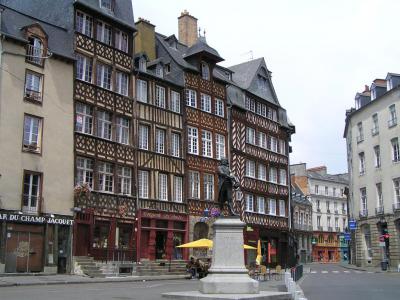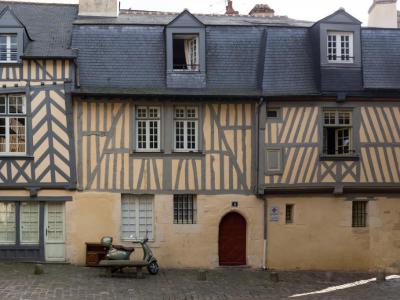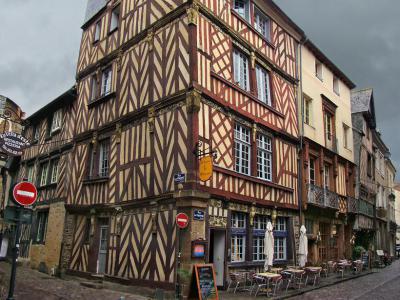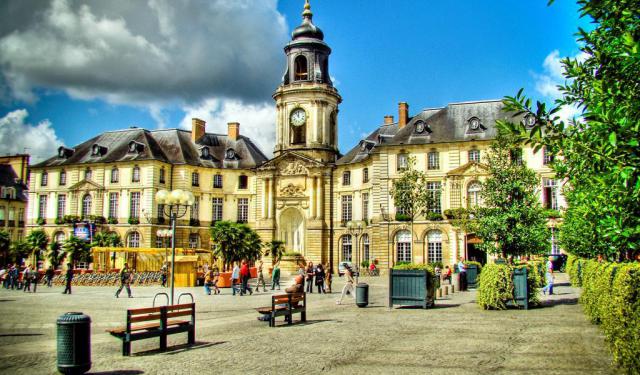Medieval Houses Walking Tour (Self Guided), Rennes
From the late Middle Ages through to the end of the Ancien Régime (the period of Bourbon rule in France, from 1589 to 1789), a multitude of half-timbered houses were built in Brittany, and particularly in Rennes. Even today, the Breton capital is where half-timbered houses remain the most prevalent style of architecture, and a key element of the cultural heritage of the region reiterated in many of its locations.
In Rennes, dotting here and there, there are in total up to 370 ancient houses of this type, lining the streets, preserved at their best, and spectacular both inside and out. Strolling around the city's historic center, you can't help noticing these picturesque marvels everywhere you look, leaning against one another or tilting questionably as if about to collapse, creating a rather fairytale-like atmosphere.
Wandering through the streets of Rennes is like taking a step back in time. Your mind is easily drawn to imagine how life might have been back in the Medieval era when you step into a bar, shop or restaurant set in a vibrant building of nearly six centuries of age.
At Place du Champ Jacquet these furnished dwellings once served as accommodation for the lawyers who flocked here to work at the local Parliament.
In Place des Lices you can't miss the eye-catching twin mansions, the Hôtel Racapée de la Feuillée and the Hôtel de la Louvre; their vertical bay windows and sweeping, double-flight staircase in front of the entrance are reminiscent of the stairs at Parliament.
In Rennes, dotting here and there, there are in total up to 370 ancient houses of this type, lining the streets, preserved at their best, and spectacular both inside and out. Strolling around the city's historic center, you can't help noticing these picturesque marvels everywhere you look, leaning against one another or tilting questionably as if about to collapse, creating a rather fairytale-like atmosphere.
Wandering through the streets of Rennes is like taking a step back in time. Your mind is easily drawn to imagine how life might have been back in the Medieval era when you step into a bar, shop or restaurant set in a vibrant building of nearly six centuries of age.
At Place du Champ Jacquet these furnished dwellings once served as accommodation for the lawyers who flocked here to work at the local Parliament.
In Place des Lices you can't miss the eye-catching twin mansions, the Hôtel Racapée de la Feuillée and the Hôtel de la Louvre; their vertical bay windows and sweeping, double-flight staircase in front of the entrance are reminiscent of the stairs at Parliament.
How it works: Download the app "GPSmyCity: Walks in 1K+ Cities" from Apple App Store or Google Play Store to your mobile phone or tablet. The app turns your mobile device into a personal tour guide and its built-in GPS navigation functions guide you from one tour stop to next. The app works offline, so no data plan is needed when traveling abroad.
Medieval Houses Walking Tour Map
Guide Name: Medieval Houses Walking Tour
Guide Location: France » Rennes (See other walking tours in Rennes)
Guide Type: Self-guided Walking Tour (Sightseeing)
# of Attractions: 5
Tour Duration: 1 Hour(s)
Travel Distance: 0.9 Km or 0.6 Miles
Author: DanaOffice
Sight(s) Featured in This Guide:
Guide Location: France » Rennes (See other walking tours in Rennes)
Guide Type: Self-guided Walking Tour (Sightseeing)
# of Attractions: 5
Tour Duration: 1 Hour(s)
Travel Distance: 0.9 Km or 0.6 Miles
Author: DanaOffice
Sight(s) Featured in This Guide:
- Place Sainte-Anne (Sainte-Anne Square)
- Place du Champ Jacquet (Champ-Jacquet Square)
- Racapé de La Feuillée and Louvre Hotels
- Rue de la Psalette (Psalette Street)
- Rue du Chapitre (Chapter Street)
1) Place Sainte-Anne (Sainte-Anne Square)
Situated north of the historic heart of Rennes, the old Sainte-Anne square has been around since the Roman period when it housed a pagan Mercury temple and triumphal arch. In the Middle Ages, the square was still found outside the city walls, being part of a suburb not far from the Saint Michael's Gate and Fullers' Gate.
Nowadays, situated close to Rue Saint-Michel with its many bars, the square appears rather lively, especially in the evening. There are several architectural monuments in the area, including the new Saint-Aubin church, Our Lady of Good News basilica, built in 1916 and still unfinished. Its predecessor, the old Saint-Aubin church, once stood in the western part of the square, until 1904.
The new basilica is nested among Medieval-style half-timbered houses, five of which, including the Hôtel de Bretagne (built in 1586), at No. 9, and houses No. 10, 17, 18 and 19, are listed as historical monuments. The No. 19 house, formerly a private mansion of Jean Leperdit, who lived here until his death in 1823, is now occupied by Ty Anna Tavern.
Prior to 2002, the square had housed a large parking lot which has since been cleared and pedestrianized. Several excavations occurred during the construction of the Sainte-Anne metro station and the Congress Center (on the site of the former Jacobin Convent) have dug up more evidence attesting to the rich history of this area.
Nowadays, situated close to Rue Saint-Michel with its many bars, the square appears rather lively, especially in the evening. There are several architectural monuments in the area, including the new Saint-Aubin church, Our Lady of Good News basilica, built in 1916 and still unfinished. Its predecessor, the old Saint-Aubin church, once stood in the western part of the square, until 1904.
The new basilica is nested among Medieval-style half-timbered houses, five of which, including the Hôtel de Bretagne (built in 1586), at No. 9, and houses No. 10, 17, 18 and 19, are listed as historical monuments. The No. 19 house, formerly a private mansion of Jean Leperdit, who lived here until his death in 1823, is now occupied by Ty Anna Tavern.
Prior to 2002, the square had housed a large parking lot which has since been cleared and pedestrianized. Several excavations occurred during the construction of the Sainte-Anne metro station and the Congress Center (on the site of the former Jacobin Convent) have dug up more evidence attesting to the rich history of this area.
2) Place du Champ Jacquet (Champ-Jacquet Square)
Perhaps the most photogenic spot in Rennes, Champ-Jacquet Square takes its names after the gate Porte Jacquet, formerly part of the old (15th-century) bulwark, located nearby.
The triangular square's architecture traces the history of Rennes from as far back as the Middle Ages and bears the scars of the Fire of 1720 that ravaged the city. That year, the flames totally consumed the southern part of the square, while sparing its northern part, thus clearly marking the limits of the fire's advance. Stone houses built after the fire today stand face-to-face with the survived structures of wood and plaster.
These celebrated half-timbered houses form a wicked "house of cards" composition, looking at which unstable and uneven façades is now hard to imagine that, back in the 17th century, when they were built, the opposite was true: the buildings were impressively solid and regular.
These furnished dwellings served as accommodation for lawyers who flocked here to work at the Parliament. The opening of Rue Leperdit (left) created a void that caused the façades to slope. With no stone wall to separate the buildings the latter warped over time – a problem quite typical in wood construction: shifting suppleness of the structure.
In the center of the square stands a two-meter bronze statue of Jean Leperdit, a mayor of Rennes during the turbulent period of the Revolution. The mayor is depicted tearing up a royal edict with a list of those condemned to the guillotine. Praised as a ray of light in the time of darkness, Leperdit was famously reported to have said, whilst ripping that document: "They are outside the law, [but] not outside humanity."
If you look to the side, at number 5, you will see the Hôtel Hay de Tizé. Built in 1665, this is a stunning example of a fusion of genres and materials: a half-timbered façade, a tuffeau-stone first floor and granite foundations. In other words, an architectural cocktail, Breton-style.
Since the installation of the second Metro line, Champ-Jacquet Square has been pedestrianized. Today, the square is a condensation of Rennes' life and is once again a rendezvous place, abundant in restaurants, cafes, and creperies, as well as boutiques specialized in "made in France" merchandise.
The triangular square's architecture traces the history of Rennes from as far back as the Middle Ages and bears the scars of the Fire of 1720 that ravaged the city. That year, the flames totally consumed the southern part of the square, while sparing its northern part, thus clearly marking the limits of the fire's advance. Stone houses built after the fire today stand face-to-face with the survived structures of wood and plaster.
These celebrated half-timbered houses form a wicked "house of cards" composition, looking at which unstable and uneven façades is now hard to imagine that, back in the 17th century, when they were built, the opposite was true: the buildings were impressively solid and regular.
These furnished dwellings served as accommodation for lawyers who flocked here to work at the Parliament. The opening of Rue Leperdit (left) created a void that caused the façades to slope. With no stone wall to separate the buildings the latter warped over time – a problem quite typical in wood construction: shifting suppleness of the structure.
In the center of the square stands a two-meter bronze statue of Jean Leperdit, a mayor of Rennes during the turbulent period of the Revolution. The mayor is depicted tearing up a royal edict with a list of those condemned to the guillotine. Praised as a ray of light in the time of darkness, Leperdit was famously reported to have said, whilst ripping that document: "They are outside the law, [but] not outside humanity."
If you look to the side, at number 5, you will see the Hôtel Hay de Tizé. Built in 1665, this is a stunning example of a fusion of genres and materials: a half-timbered façade, a tuffeau-stone first floor and granite foundations. In other words, an architectural cocktail, Breton-style.
Since the installation of the second Metro line, Champ-Jacquet Square has been pedestrianized. Today, the square is a condensation of Rennes' life and is once again a rendezvous place, abundant in restaurants, cafes, and creperies, as well as boutiques specialized in "made in France" merchandise.
3) Racapé de La Feuillée and Louvre Hotels
Two of Rennes's most popular half-timbered mansions are found on Place des Lices. Built between 1658 and 1680, these twin buildings, standing side-by-side in the square renowned for its Saturday-morning market, are the Racapé de la Feuillée Hotel (whose main south façade is at No. 28 Place des Lices, and rear north façade at No. 23 Rue Saint-Louis) and the Hôtel de la Louvre, aka Hôtel de La Noue, located at No. 26 Place des Lices (main south façade) and No. 21 Rue Saint-Louis (rear north façade).
The Racapé de la Feuillée building is made from stone and bare timber, without corbels. The wooden framework currently visible on the façade wasn’t seen originally. At the time, wood was used for its cheapness, to imitate stone with a help of coating.
A double-flight staircase in front of the entrance gives this house a parliamentarian air, which is only logical, considering that its tenants were none other than local parliamentarians.
The adjoining buildings show striking similarities, such as three large arched arcades holding old stable doors. The Louvre hotel's main entrance is a red double door with barred windows. A pointed tympanum above the door holds a circular window. The door is flanked by grooved pilasters. There is a three-sided porch with five steps.
Both buildings were classified as historical monuments in 1962.
To get an idea of the inside, you can climb the stairs at number 28, where the Hôtel Racapée de la Feuillée serves as an excuse to step inside two wonderful boutiques. The one on the left is Aperçu, a fantastic find for interior design enthusiasts and just the ticket for snapping up premium items (furniture and fabrics as well as teas and beauty products). To the right is La Poudrerie, a beauty bar and make-up salon. As you make your way between these two venues, admire the artwork on the open-air central staircase, worth a visit as such. Combining a spot of shopping with a culture fix!
The Racapé de la Feuillée building is made from stone and bare timber, without corbels. The wooden framework currently visible on the façade wasn’t seen originally. At the time, wood was used for its cheapness, to imitate stone with a help of coating.
A double-flight staircase in front of the entrance gives this house a parliamentarian air, which is only logical, considering that its tenants were none other than local parliamentarians.
The adjoining buildings show striking similarities, such as three large arched arcades holding old stable doors. The Louvre hotel's main entrance is a red double door with barred windows. A pointed tympanum above the door holds a circular window. The door is flanked by grooved pilasters. There is a three-sided porch with five steps.
Both buildings were classified as historical monuments in 1962.
To get an idea of the inside, you can climb the stairs at number 28, where the Hôtel Racapée de la Feuillée serves as an excuse to step inside two wonderful boutiques. The one on the left is Aperçu, a fantastic find for interior design enthusiasts and just the ticket for snapping up premium items (furniture and fabrics as well as teas and beauty products). To the right is La Poudrerie, a beauty bar and make-up salon. As you make your way between these two venues, admire the artwork on the open-air central staircase, worth a visit as such. Combining a spot of shopping with a culture fix!
4) Rue de la Psalette (Psalette Street)
Curving behind the apse of the Saint-Pierre Cathedral in Rennes is Rue de la Psalette, a short, narrow lane between Rue du Chapitre and Rue Saint-Sauveur. The word "psalette" is a derivative of the verb "psalmodier", which means reciting of psalms in a low monotonous tone. It also refers to the children's choir in church or a building where these children were housed.
The one at No. 8, acquired by the Cathedral Chapter in 1476, is exactly that sort of building. Its acquisition contract, however, wasn't signed until much later, under the episcopate of Jacques d'Épinay, in the mid 1700s.
Also, whilst in this alley, you can notice the former hotel Le Gonidec, at No. 1, otherwise known as the "Corner House". Dating from 1609, this building features two floors behind a half-timbered facade, with chevrons and oeil-de-boeuf (bull's-eye), a small circular window, resembling a wheel. The other houses nearby, with restored timber framing and semicircular doors, date from the 17th and 18th centuries.
However, the oldest house in the neighborhood, much as in the whole of Rennes, is at No. 12. It is believed to date back as far as the late 14th century, judging by its sandpit complete with the joist and the spacer.
The one at No. 8, acquired by the Cathedral Chapter in 1476, is exactly that sort of building. Its acquisition contract, however, wasn't signed until much later, under the episcopate of Jacques d'Épinay, in the mid 1700s.
Also, whilst in this alley, you can notice the former hotel Le Gonidec, at No. 1, otherwise known as the "Corner House". Dating from 1609, this building features two floors behind a half-timbered facade, with chevrons and oeil-de-boeuf (bull's-eye), a small circular window, resembling a wheel. The other houses nearby, with restored timber framing and semicircular doors, date from the 17th and 18th centuries.
However, the oldest house in the neighborhood, much as in the whole of Rennes, is at No. 12. It is believed to date back as far as the late 14th century, judging by its sandpit complete with the joist and the spacer.
5) Rue du Chapitre (Chapter Street)
Running east-west, between Calvary or Golgotha Square and Rue de Montfort, is Chapter Street. Previously, this street was known as Rue du Four-du-Chapitre for having been the place where an oven belonging to the Chapter of the Cathedral was located.
This area is a melange of architectural styles. Here, within a space of just a few square feet you can see centuries of architecture revealed in full splendour, including some rather curious old buildings, delightful to the eye.
The number of half-timbered houses still standing is quite remarkable, considering that the majority of them were built in the 17th century, before the Great Fire of 1720. Luckily, Rue du Chapitre was largely spared by fire thanks to the owner of the Hôtel de l'Escu de Runefaut, at no. 5, who had paid handsomely for having the neighbouring homes torn down, which ultimately prevented the fire from spreading further.
Built circa 1650, this hotel is a multi-coloured marvel with the façade painted in lively red and yellow ochre, a testimony to the fashion prevalent in the 17th century. Inside this hotel's courtyard is a pretty wooden staircase with turned balusters. In 1988, the building underwent restoration, with its original geometric effect recreated in the spirit of the period using the traces of polychromy discovered during excavations. On the ground floor, it has a tiny restaurant called Le Little Attic.
Other houses of note include the Hôtel de Talhouêt, at no. 3 – with two half-timbered floors and a long façade – extant since the 18th century, and first known as the Hôtel du Faouët and then the Hôtel de Villaudon.
At no. 6 is the splendid Hôtel de Blossac, the former residence of the commander-in-chief of the province, boasting a monumental entrance. Built on the site of the former outbuildings of the Hôtel de Brie, this mansion is an architectural marvel of the Age of Enlightenment. Transformed into a residential building in the 19th century, starting from 1977 it has been the headquarters of the Regional Department of Cultural Affairs.
At no. 8, the Hôtel de Brie or Bois de la Motte, dating from 1624, has a pilastered façade, styled as a mix of Classical and Renaissance.
At the corner of Rue de la Psalette and 22 Rue du Chapitre you will spot another beautiful Renaissance decoration. This parliamentarian’s house of the 16th century had an extra floor added in the 18th. Of a particular note here is an interesting detail: one of the corner panels was made from granite to prevent damage caused by cartwheels navigating tight corners.
This area is a melange of architectural styles. Here, within a space of just a few square feet you can see centuries of architecture revealed in full splendour, including some rather curious old buildings, delightful to the eye.
The number of half-timbered houses still standing is quite remarkable, considering that the majority of them were built in the 17th century, before the Great Fire of 1720. Luckily, Rue du Chapitre was largely spared by fire thanks to the owner of the Hôtel de l'Escu de Runefaut, at no. 5, who had paid handsomely for having the neighbouring homes torn down, which ultimately prevented the fire from spreading further.
Built circa 1650, this hotel is a multi-coloured marvel with the façade painted in lively red and yellow ochre, a testimony to the fashion prevalent in the 17th century. Inside this hotel's courtyard is a pretty wooden staircase with turned balusters. In 1988, the building underwent restoration, with its original geometric effect recreated in the spirit of the period using the traces of polychromy discovered during excavations. On the ground floor, it has a tiny restaurant called Le Little Attic.
Other houses of note include the Hôtel de Talhouêt, at no. 3 – with two half-timbered floors and a long façade – extant since the 18th century, and first known as the Hôtel du Faouët and then the Hôtel de Villaudon.
At no. 6 is the splendid Hôtel de Blossac, the former residence of the commander-in-chief of the province, boasting a monumental entrance. Built on the site of the former outbuildings of the Hôtel de Brie, this mansion is an architectural marvel of the Age of Enlightenment. Transformed into a residential building in the 19th century, starting from 1977 it has been the headquarters of the Regional Department of Cultural Affairs.
At no. 8, the Hôtel de Brie or Bois de la Motte, dating from 1624, has a pilastered façade, styled as a mix of Classical and Renaissance.
At the corner of Rue de la Psalette and 22 Rue du Chapitre you will spot another beautiful Renaissance decoration. This parliamentarian’s house of the 16th century had an extra floor added in the 18th. Of a particular note here is an interesting detail: one of the corner panels was made from granite to prevent damage caused by cartwheels navigating tight corners.
Walking Tours in Rennes, France
Create Your Own Walk in Rennes
Creating your own self-guided walk in Rennes is easy and fun. Choose the city attractions that you want to see and a walk route map will be created just for you. You can even set your hotel as the start point of the walk.
Rennes Historical Churches Walking Tour
Historical churches occupy a significant place in the cultural identity of Rennes, France. Travelers with a keen interest in religious history and architecture will find plenty to look at in this town.
Standing out majestically among the local ecclesiastical landmarks is Rennes Cathedral. Built in the 12th century, it underwent a centuries-long transformation from its Gothic origins to its... view more
Tour Duration: 1 Hour(s)
Travel Distance: 2.1 Km or 1.3 Miles
Standing out majestically among the local ecclesiastical landmarks is Rennes Cathedral. Built in the 12th century, it underwent a centuries-long transformation from its Gothic origins to its... view more
Tour Duration: 1 Hour(s)
Travel Distance: 2.1 Km or 1.3 Miles
Rennes Introduction Walking Tour
Rennes began its existence as Condate Redonum, a Gallic and Roman town at the confluence of the Ille and Vilaine rivers. During medieval times, it became one of the three major cities of Brittany, together with Vannes and Nantes. The city played an important role in the Stamped Paper Revolt in 1675. During the French Revolution, it became the headquarters of the republican army in the fighting... view more
Tour Duration: 2 Hour(s)
Travel Distance: 2.9 Km or 1.8 Miles
Tour Duration: 2 Hour(s)
Travel Distance: 2.9 Km or 1.8 Miles
The Most Popular Cities
/ view all










